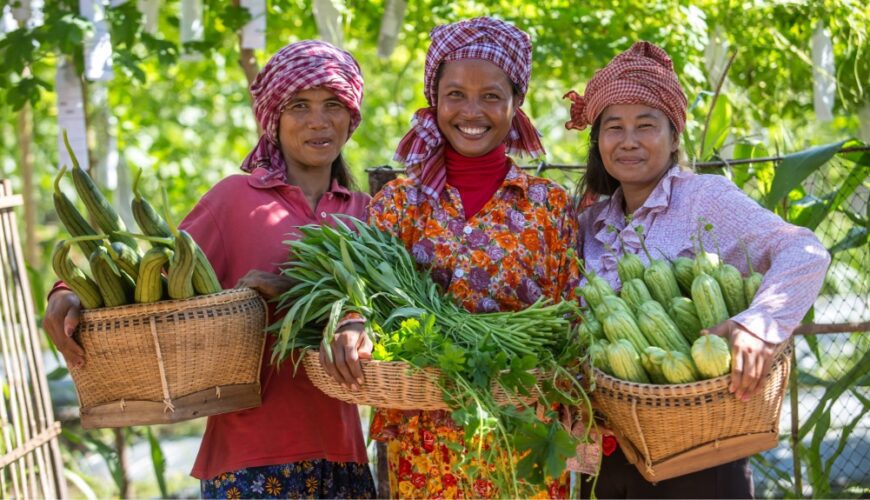Cambodia is a country with a rich agricultural heritage and a promising potential for further development. Agriculture is the backbone of the Cambodian economy, accounting for about 22% of the gross domestic product (GDP) and employing about 3 million peoplehttps://kh.usembassy.gov/fast-facts-about-cambodias-agriculture-sector/. Rice is the main crop and staple food of the country, followed by other crops such as cassava, maize, sugarcane, vegetables, and fruits. Cambodia also has a significant livestock and fisheries sector, as well as a growing forestry and rubber industry.
Cambodia has achieved remarkable progress in its agricultural sector over the past two decades, thanks to favorable weather conditions, improved technologies, expanded irrigation, increased mechanization, better access to markets, and supportive policies. According to the Food and Agriculture Organization of the United Nations (FAO), Cambodia’s agricultural gross production grew by 8.7% annually during 2004-2012, which was among the highest in the world (https://www.fao.org/countryprofiles/index/en/?iso3=KHM). The country also reduced its poverty rate from 53% in 2004 to 18% in 2012, lifting four million people out of poverty (https://www.worldbank.org/en/country/cambodia/publication/cambodian-agriculture-in-transition-opportunities-and-risks). More than 60% of this poverty reduction was attributed to positive developments in the agriculture sector (https://www.worldbank.org/en/country/cambodia/publication/cambodian-agriculture-in-transition-opportunities-and-risks).
However, Cambodia’s agricultural sector also faces many challenges and risks that could hamper its future growth and sustainability. Some of these challenges include:
- The limited availability and quality of land and water resources, as well as the adverse impacts of climate change and natural disasters on agricultural production and food security.
- The low productivity and profitability of smallholder farms, which constitute about 80% of the total farms in the country. These farms often lack access to quality inputs, credit, extension services, technology, and market information.
- The high dependence on rice as the main source of income and food for most farmers, which makes them vulnerable to price fluctuations and market shocks. Rice also competes with other more profitable crops for land and water resources.
- The weak institutional and regulatory framework for agricultural development, which affects the quality and safety of agricultural products, the enforcement of contracts and property rights, the protection of natural resources and biodiversity, and the promotion of innovation and competitiveness.
To overcome these challenges and seize the opportunities for further development, Cambodia needs to diversify its agricultural sector and increase its value addition and competitiveness. This would require investing in various areas such as:
- Improving the infrastructure and services for irrigation, drainage, storage, processing, transportation, and marketing of agricultural products.
- Enhancing the research and development capacity and extension system for developing and disseminating new technologies, varieties, practices, and standards that suit the local conditions and market demands.
- Strengthening the institutional and human resource capacity and coordination among different stakeholders involved in agricultural development, such as government agencies, private sector actors, civil society organizations, farmers’ groups, and development partners.
- Promoting the participation and empowerment of smallholder farmers, especially women and youth, in decision-making processes and value chains related to agricultural production and marketing.
- Supporting the development of agro-industries and agribusinesses that can add value to agricultural products and create employment opportunities for rural people.
- Encouraging the adoption of sustainable and climate-smart agriculture practices that can enhance the resilience and adaptation of farmers to environmental shocks and stresses.
By investing in these areas, Cambodia can unlock its agricultural potential and achieve its vision of becoming a modernized and diversified agricultural economy by 2030 (https://www.fao.org/countryprofiles/index/en/?iso3=KHM). This would not only contribute to its economic growth and poverty reduction goals but also to its food security and nutrition objectives. According to FAO estimates, Cambodia has achieved food self-sufficiency at the national level but still faces challenges in ensuring food access, utilization, stability, and quality at the household level (https://www.fao.org/cambodia/fao-in-cambodia/cambodia-at-a-glance/en/). Investing in agriculture can help address these challenges by increasing food availability, affordability, diversity, and safety for all Cambodians.
In conclusion, Cambodia’s agriculture sector offers many opportunities for investors who are interested in tapping into a dynamic and growing market with abundant natural resources and human capital. However, investors also need to be aware of the risks and challenges that may affect their returns and sustainability. Therefore, investors should conduct a thorough due diligence and feasibility study before entering the Cambodian agriculture sector, and seek partnerships and collaborations with local stakeholders who can provide them with relevant information and support.

